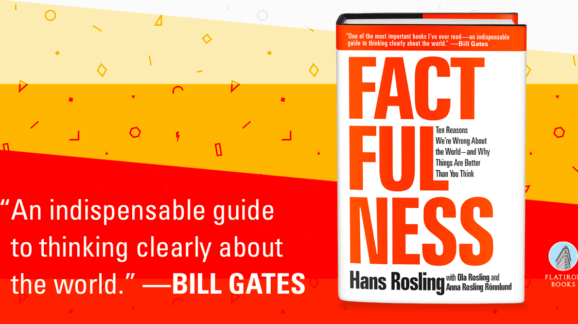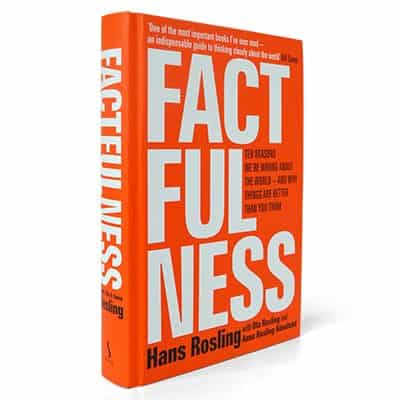Best Books of 2018: Factfulness

 Review of Factfulness: Ten Reasons We’re Wrong About the World-and Why Things Are Better Than You Think (Flatiron Books, 2018) by Hans Rosling with Ola Rosling and Anna Rosling Rönnlund.
Review of Factfulness: Ten Reasons We’re Wrong About the World-and Why Things Are Better Than You Think (Flatiron Books, 2018) by Hans Rosling with Ola Rosling and Anna Rosling Rönnlund.
Think Julian Simon, Matt Ridley, and Steven Pinker’s data-driven optimism, mixed with Michael Shermer and Bryan Caplan’s awareness of human cognitive biases, as told by a kindly, avuncular Norwegian. The book reads easily, is visually savvy, and has a friendly, non-polemic tone.
Rosling, who passed away of cancer while writing this book, wanted it to be his last, grand statement. He wants people to simultaneously believe two things: that the state of the world can be both bad and getting better. Hundreds of millions of people still live in absolute poverty. But for the first time in history, the global absolute poverty rate is now below 10 percent. Improvement is coming so fast that the number of people in poverty is going down even as population increases.
Most people think in binaries—left and right, good and bad, and so on. Rosling encourages nuance. Rather than a simple binary rich and poor countries, Rosling uses a four-level framework. Level one is absolute poverty—subsistence farming, little or no electricity, crude sanitation, high disease rates, and low life expectancy. Level four is where the rich countries are—the Anglosphere, most of Europe, and the Asian tigers. When people think of rich and poor countries, they tend to think of either level one or level four countries. As it turns out, most people in the world are middle class—they live in level two and level three countries. In varying degrees, these countries offer better health and sanitation than in level one countries, along with some industrial development, education for children instead of labor, some degree of political and lifestyle freedom, and so on.
One thing I especially like about Rosling’s framework is that countries can level up. Prosperity is a process, not an on/off switch. And the number of levels is theoretically infinite. Rosling chose to use four levels, but a more granular analyst can use as many levels as they want. More importantly, it may well be that what Rosling describes as a level four country today will be startlingly poor a century from now. Most of the world will have leveled up to the equivalent of level five or higher.
Rosling also provides an important public service in teaching people how to look at data. The most important example is the lonely number fallacy:
Never believe that one number on its own can be meaningful. If you are offered one number, always ask for at least one more. Something to compare it with. Be especially careful about big numbers. (p. 130)
I used this advice in my review of Trump economic advisor Peter Navarro’s coauthored book with Greg Autry, Death by China. The data won’t allow Navarro and Autry to make the case they want, so they have to resort to trickery:
Navarro and Autry give just such a lonely number when they argue that, “On [President George W.] Bush’s watch alone, the United States surrendered millions of jobs to China.” (p. 10) Let’s give that large, lonely number some company. In January 2001, when Bush took office, the U.S. labor force was 143.8 million people. When his term expired in January 2009, it was 154.2 million people, despite the economy being in recession. The data are here.
So even if “the United States surrendered millions of jobs to China,” those losses were outweighed by gains elsewhere, most of which have nothing to do with trade policy.
Keep this in mind whenever you see a scary number in a news story—if it doesn’t come with company or context, it’s analytically useless at best.
Rosling’s book has been warmly received by a politically diverse audience, and rightfully so. Rosling’s optimism is based on widely available data, not his ideological priors. In areas where the world is not improving, he is quick to point to it as a reform priority.
More importantly, the data show that the world’s arrows are almost all pointing up. Few people realize this—as Rosling humorously shows, most people perform worse than chimpanzees on a simple multiple choice quiz about human well-being. The errors are not random—they are overly pessimistic in participants across countries and in every demographic category.
Rosling was as effective as anyone in trying to correct pessimistic bias with facts, not least through his easy-to-understand bubble charts. Rosling’s son, Ola Rosling, and daughter-in-law, Anna Rosling Rönnlund, are carrying on his work with their group Gapminder—see, for example, their tour of Dollar Street that shows the various gradations between countries in levels one through four.
Things are bad in many places, but getting better. In fact, for most people in most places, living standards today are the best they’ve ever been. It is up to us to see that the process continues. To do that, we need to be aware of both the facts on the ground and our inborn cognitive biases that prevent us from seeing those facts clearly. From there, action. Use your head, not just your heart. You need both.
Previous post in the Best Books of 2018 series:
- “Judicial Fortitude: The Last Chance to Rein in the Administrative State” (Encounter Books, 2018)